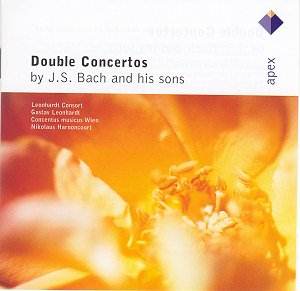Being the son of a
famous father isn't always easy. The
sons of Johann Sebastian Bach knew all
about that. Carl Philipp Emanuel told
his father's first biographer, Johann
Nikolaus Forkel, that he and his older
brother Wilhelm Friedemann "necessarily
had to choose their own kind of style
because they never would have matched
their father in his style."
This disc gives an
excellent opportunity to compare the
styles of members of the Bach family.
It starts and ends with double concertos
by Johann Sebastian and in between we
hear double concertos written by two
of his sons, with a composition by his
youngest son Johann Christian in the
middle. That makes sense, as in many
ways he was the one who moved more away
from his father than the other two.
The disc starts with
one of the most popular compositions
of Johann Sebastian, the concerto for
oboe, violin, strings and basso continuo.
This is no original concerto, but a
reconstruction of what is thought to
be the original of the concerto best
known in the scoring for two harpsichords
with strings and basso continuo.
After that the concerto
by Carl Philipp Emanuel Bach, written
in the year of his death, shows big
changes in the musical taste during
the 18th century. Here we find a much
more personal and emotional style, which
is also a feature of his compositions
for keyboard solo. His favourite keyboard
instrument was the clavichord, and when
he was improvising he sometimes let
his tears flow, something one would
never expect from his father. The combination
of harpsichord and fortepiano in one
concerto is remarkable. Even more so
is the fact that they are treated equally.
Can this perhaps be interpreted as a
statement that the 'old-fashioned' harpsichord
isn't inferior to the 'modern' fortepiano?
That is certainly possible, considering
the fact that Carl Philipp Emanuel at
the end of his life acted as a strong
defender of his father's style.
The next piece is by
Johann Christian Bach, Johann Sebastian's
youngest son. He moved literally far
away from his fatherís world; he went
to Italy to study with Padre Martini,
converted to Catholicism, and then travelled
to London, where he became a key figure
in English musical life. He organised
- together with the viola da gamba virtuoso
Carl Friedrich Abel - the 'Bach-Abel
concerts', where the newest music from
all over Europe was performed. Certainly
many Sinfonia concertantes were played
during these concerts, as this was one
of the most prominent forms of the 'galant'
style which spread over Europe. Many
such were written, almost always in
major keys, often with only two movements.
Their main aim was to entertain, and
give the audience nice melodies to enjoy.
It shouldn't be overlooked, though,
that even this kind of entertainment
had a higher aim: the moral improvement
of the audience.
Next comes Wilhelm
Friedemann: he was Johann Sebastian's
eldest - and without any doubt favourite
- son, to whose musical education Bach
spent a lot of time and energy. Of all
Johann Sebastian's sons Wilhelm Friedemann
stays closest to the style of his father.
One wonders why. Perhaps he just didn't
know which style to adopt. His sacred
cantatas could easily be attributed
to his father, but in his keyboard works
he adopts a much more personal style,
with strong reminiscences of the 'Empfindsamkeit'.
The double concerto looks to follow
the traditional pattern of the baroque
concerto, but during the work all sorts
of things happen which signify that
it belongs to a different era. It is
tempting to see the ambiguous character
of this concerto as a reflection of
the rather unstable character which
is often ascribed to Wilhelm Friedemann.
More likely this is simply a demonstration
of his problems in figuring out which
of the styles then in vogue suited him
best.
The disc closes with
another concerto by father Bach. This
is especially popular in its original
form as the concerto for two violins,
strings and basso continuo in d minor
(BWV 1043). There is no lack of expression
here, but it is of an entirely different
kind than in the concertos by the Bach
sons: more formalistic, based on the
general rules of affect and the rhetorics
of the baroque.
The recordings all
date from the 1960s, the early days
of historical performance practice and
the use of period instruments. It is
hardly fair to compare these recordings
with more recent ones, which are mostly
better as far as the playing technique
is concerned. Here the players of the
trumpets and horns have problems playing
tune all the time, and the string players
use a lot more vibrato than their colleagues
of today. But it is very good that these
recordings are available again: I have
always considered the recording of the
works by the Bach sons as one of the
best Leonhardt and Harnoncourt made.
One finds here a nice combination of
the strongest features of both these
great artists: Harnoncourtís feeling
for the dynamic shades within the musical
phrases and Leonhardt's unique rhythmic
drive. The latter quality is impressively
demonstrated in the concerto for two
harpsichords by Johann Sebastian.
If there are things
to criticise - apart from the technical
shortcomings now and then - it is perhaps
that the adagio of the concerto BWV
1062 is played more like an andante
and could be a little slower. And the
'tempo di minuetto' from Johann Christian's
Sinfonia concertante is a little too
heavy. But in general these are fine
recordings, which can be strongly recommended.
By the way: the references
on the tray of this disc are not quite
accurate. Only in the works of the Bach
sons both orchestras play together.
The first item is played by the Concentus
Musicus, the last by the Leonhardt-Consort.
Johan van Veen







